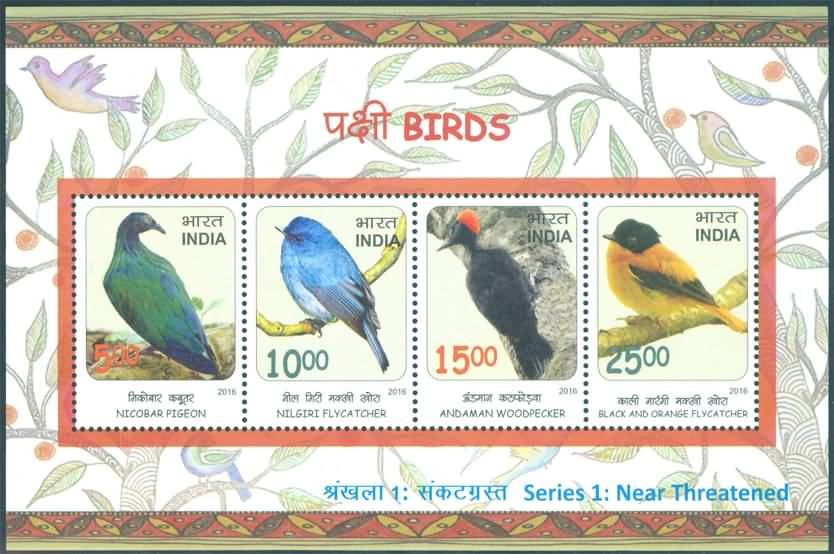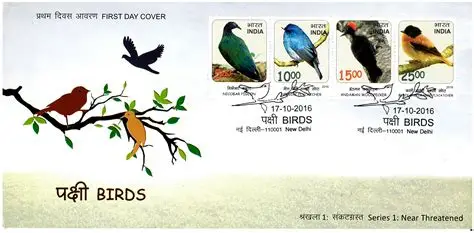Birds – Series 1: Near Threatened

Technical Data
| Date of Issue | October 17, 2016 |
|---|---|
| Denomination | Rs. 55 |
| Quantity | 100,000 |
| Perforation | 13¾ x 13¼ |
| Printer | Security Printing Press, Hyderabad |
| Printing Process | Wet Offset |
| Watermark | No Watermark |
| Colors | Multicolor |
| Credit (Designed By) | Ms. Nenu Gupta |
| Catalog Codes |
Michel IN BL147 Yvert et Tellier IN BF134 Stanley Gibbons IN MS3186 |
| Themes | Animals (Fauna) | Birds | Pigeons | Woodpeckers |
Near Threatened Birds of India – A Philatelic Tribute
Birds inhabit every corner of the Earth—from the icy Arctic and Antarctic regions to the hot and dry deserts of the Sahara and Kalahari, from the lush tropical forests of South America and Africa to the misty Himalayan ranges and remote oceanic islands. India alone is home to nearly 1,200 bird species, making it one of the richest countries in avian diversity.
As warm-blooded animals covered with feathers, birds display remarkable adaptability: they can fly, walk, and swim, and are universally known for laying eggs. However, many species across the world are under threat due to habitat loss, climate change, hunting, and human interference.
IUCN Red List and Near Threatened Category
The International Union for Conservation of Nature (IUCN) assesses the global conservation status of species. In its Red List, birds are classified into nine categories based on population trends, habitat range, and survival threats.
One of these categories is Near Threatened (NT)—referring to species that are not yet endangered but are likely to face such risk in the near future.
To highlight and raise awareness about these vulnerable species, the Department of Posts proudly issues a set of four commemorative stamps featuring four remarkable Near Threatened birds of India.
1. Nicobar Pigeon (Caloenas nicobarica)
IUCN Category: Near Threatened
The Nicobar Pigeon is a striking island specialist found in the Andaman and Nicobar Islands. It is the only living species of the genus Caloenas. Though its global population has not been precisely measured, it is generally considered scarce to rare, except on smaller, undisturbed islets where it may be locally common.
Key Features & Habitat
- Breeds in dense colonies on small, wooded offshore islands.
- Forages on nearby larger islands or the mainland, up to 500 m inland.
- Prefers remote, uninhabited islets close to extensive lowland rainforest.
Threats
- Heavy trapping for food and the pet trade.
- Hunting for their valuable gizzard stones.
- Habitat destruction due to conversion of small islands into plantations.
- Predation by introduced species such as rats and cats.
Its declining numbers underscore the fragility of island ecosystems.
2. Nilgiri Flycatcher (Eumyias albicaudatus)
IUCN Category: Near Threatened
Endemic to the Western Ghats, the Nilgiri Flycatcher occupies a moderately small and fragmented habitat range. Although common in suitable habitat, increasing human activities pose long-term risks.
Key Features & Habitat
- Prefers evergreen hill forests, sholas, wooded stream edges, and shade-grown plantations.
- Typically found between 600 m and high-elevation summits, most abundant above 1,200 m.
- Feeds on insects and berries; often associates loosely with other flycatchers.
- Breeding season: February to June.
Threats
- Habitat loss due to forest encroachment, fuelwood extraction, and plantation expansion.
- Increasing human population causing pressure on fragile Western Ghat ecosystems.
Though adaptable to mildly disturbed areas, sustained habitat pressure could endanger this unique Western Ghats resident.
3. Black-and-Orange Flycatcher (Ficedula nigrorufa)
IUCN Category: Near Threatened
Another Western Ghats endemic, the Black-and-Orange Flycatcher is known for its vivid plumage and restricted range. It remains locally common but faces several emerging threats.
Key Features & Habitat
- Found in shola forests, dense thickets, bamboo and rattan undergrowth, and moist ravines.
- Occurs between 700 m and the highest peaks.
- Forages close to the ground, hopping through leaf litter.
- Breeding season: March to July.
Threats
- Habitat destruction from tea plantations, illegal logging, and forest product harvesting.
- Hydroelectric projects and road construction causing fragmentation.
- Grazing and encroachment reducing suitable vegetation cover.
Although tolerant of lightly modified habitats, unchecked habitat degradation may threaten its survival.
4. Andaman Woodpecker (Dryocopus hodgei)
IUCN Category: Near Threatened
The formidable Andaman Woodpecker is exclusively found in the Andaman Islands, making it a highly specialised island species. Its striking appearance and adaptability make it one of the archipelago’s most iconic birds.
Key Features & Habitat
- Common resident of tropical evergreen forests and open areas with tall trees.
- Forages on trunks and large branches of mature trees.
- Mostly restricted to lowland forests.
Threats
- Habitat loss and degradation due to agriculture, grazing, and logging.
- Rapid human population increase on major islands leading to forest pressure.
- Although still widespread, continued monitoring is necessary.
This species remains secure for now, but continued habitat disturbance could impact its future populations.
Conclusion
These four birds—each unique in beauty, behaviour, and ecological significance—represent the delicate balance of India’s biodiversity. The Department of Posts, through this commemorative stamp set, honors not only the birds themselves but also the urgent need to protect their habitats and ensure their survival for generations to come.
India’s rich avifauna is a national treasure. Recognizing and safeguarding Near Threatened species today will ensure that they never slip into the endangered realm tomorrow.
First Day Cover


Leave a Comment
You must be logged in to post a comment.